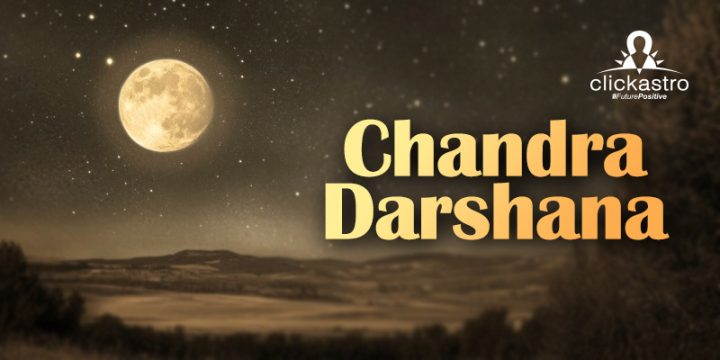Contents[hide]
Chandra Darshana Dates 2025
January 1, 2025, Wednesday
- Chandra Darshanaa
- 06:15 PM to 07:38 PM
- Pratipada Duration: 1 Hour 22 Mins
January 30, 2025, Thursday
- Chandra Darshanaa
- 06:28 PM to 07:20 PM
- Pratipada Duration: 0 Hours 51 Mins
March 1, 2025, Saturday
- Chandra Darshanaa
- 06:33 PM to 07:50 PM
- Pratipada Duration: 1 Hour 16 Mins
March 30, 2025, Sunday
- Chandra Darshanaa
- 06:32 PM to 07:25 PM
- Pratipada Duration: 0 Hours 53 Mins
April 28, 2025, Monday
- Chandra Darshanaa
- 06:32 PM to 07:07 PM
- Pratipada Duration: 0 Hours 35 Mins
May 28, 2025, Wednesday
- Chandra Darshanaa
- 06:37 PM to 08:02 PM
- Pratipada Duration: 1 Hour 26 Mins
June 26, 2025, Thursday
- Chandra Darshanaa
- 06:44 PM to 07:48 PM
- Pratipada Duration: 1 Hour 04 Mins
July 26, 2025, Saturday
- Chandra Darshanaa
- 06:44 PM to 08:07 PM
- Pratipada Duration: 1 Hour 23 Mins
August 24, 2025, Sunday
- Chandra Darshanaa
- 06:34 PM to 07:23 PM
- Pratipada Duration: 0 Hours 48 Mins
September 23, 2025, Tuesday
- Chandra Darshanaa
- 06:18 PM to 07:12 PM
- Pratipada Duration: 0 Hours 55 Mins
October 23, 2025, Thursday
- Chandra Darshanaa
- 06:03 PM to 07:11 PM
- Pratipada Duration: 1 Hour 08 Mins
November 21, 2025, Friday
- Chandra Darshanaa
- 05:59 PM to 06:42 PM
- Pratipada Duration: 0 Hours 43 Mins
December 21, 2025, Sunday
- Chandra Darshanaa
- 06:09 PM to 07:14 PM
- Pratipada Duration: 1 Hour 05 Mins
What is Chandra Darshana?
Chandra Darshana literally means “moon viewing.” It signifies the first appearance of the crescent moon after the no-moon night. This delicate sliver of light in the sky is not just an astronomical event but a deeply spiritual one. In Hindu thought, the moon governs emotions, intellect, and the inner mind. It symbolizes clarity, calmness, and the ebb and flow of human feelings.
Because the moon becomes visible for only a short duration after sunset on this day, spotting it requires attention and planning. Panchang makers (astrological almanac experts) meticulously calculate its timing, which is crucial for devotees who want to perform rituals at the right moment.
Significance in Hinduism
Chandra Darshana is seen as a time for renewal. As the moon begins a new cycle, it inspires devotees to embark on fresh beginnings, cleanse themselves of negative emotions, and align their minds with positive thoughts. It is believed that worshipping the moon on this evening brings:- Emotional balance
- Prosperity and good fortune
- Mental clarity and spiritual calmness
Rituals and Observances
Across various regions like Tamil, Kerala, and Telugu-speaking areas, the core essence of Chandra Darshana remains the same, though the rituals may vary slightly in practice.- Fasting (Vrat): Many devotees observe a vrat on the day of Chandra Darshana. They refrain from eating throughout the day and break their fast only after sighting the moon. This act of self-control is believed to purify both body and mind.
- Puja and Offerings: In the evening, once the moon appears, devotees offer water, milk, white flowers, and uncooked rice to the moon god. These offerings are usually made in open courtyards or near temples where the moon is clearly visible.
- Chanting Mantras: One of the most commonly recited mantras is the Chandra Beej Mantra:
“Om Shraam Shreem Shroum Sah Chandraya Namah.”
This is chanted to invoke peace, emotional stability, and abundance. Some also recite Chandra Ashtakshara Stotra or Soma Stotra. - Meditation and Moon Gazing: In some traditions, especially in Kerala and Tamil regions, people sit quietly under the moonlight for meditation. This practice is believed to absorb the moon’s calming vibrations and enhance mental clarity.
Mythological Background
In Hindu mythology, the moon is personified as Chandra or Soma, one of the Navagrahas (nine planetary deities). According to ancient texts, Chandra was born from the cosmic ocean during the Samudra Manthan (churning of the ocean). Known for his radiant beauty, he was granted immortality and became the ruler of herbs and medicinal plants. One of the most well-known legends is the story of Chandra and his 27 wives, who were the daughters of Daksha Prajapati. Chandra favored Rohini, one of his wives, which led to resentment among the others. Daksha cursed Chandra, causing him to wane. Upon seeking help from Lord Shiva, Chandra was partially relieved of the curse, resulting in the moon’s cyclical phases. Thus, the waxing and waning of the moon — culminating in Chandra Darshana — are not only natural phenomena but also deeply symbolic of the balance between growth and decline, light and darkness, emotion and intellect.Why Chandra Darshana Matters Today
In a world dominated by noise, stress, and constant movement, the spiritual observance of Chandra Darshana invites a pause. It offers a chance to realign with nature, to reflect in silence, and to begin anew. The crescent moon’s gentle light reminds us that even in darkness, there is a promise of light, growth, and transformation. Whether you follow the Tamil calendar, Telugu calendar, or traditional Hindu calendar systems from other regions, this celestial event resonates universally. It transcends language and geography, uniting people in a common spiritual experience.Tips for Observing Chandra Darshana
- Check your local Panchang or calendar for exact moonrise timings.
- Try to be in a location with a clear view of the western horizon, as the crescent moon sets shortly after sunset.
- Prepare your offerings—preferably white items like milk, rice, or white flowers—and keep them ready for the evening puja.
- Maintain a calm state of mind throughout the day, and use the opportunity to introspect and reset your emotional energies.







